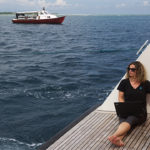January 23, 2017
Known as the jewel of the Indian Ocean, the Maldives is breathtaking in its natural beauty. But as the country with the world’s lowest ground-level elevation – on average only 1.5 meters above sea level – the Maldives faces a catastrophic threat: rising sea levels could extinguish its beauty forever.
Following the largest coral bleaching event in history last year, The Hydrous team voyaged to the islands of the Maldives in December to investigate the effects of this global-warming-related incident.
With a group of 18 scientists, divers, filmmakers, and technologists from around the world, the team conducted scientific monitoring projects that involved sampling ocean microplastics and measuring coral mortality. They also created 3D models with photogrammetry – using underwater photography and drone footage to examine coral colonies and entire islands – and collected virtual reality footage.
The divers discovered a steep drop in some coral populations and a reduction in reef complexity. How – or if – the coral reefs of the Maldives bounce back will depend on many factors, including the reefs’ own resilience and humans’ impact on climate change.
To capture, process, and share the VR footage and 3D models, the Hydrous team looked to Lenovo’s ThinkStation P510 and ThinkPad P50 to ensure its Autodesk and Adobe suites ran without delay.
Specifically, the ThinkPad P50 helped the team manage its photography and videography, as well as back up files multiple times a day without delay. The team also relied on the P50 to render 3D models, track GPS coordinates, and review virtual reality footage after dives.
In the coming months, the team will contribute the data it collected to long-term monitoring projects and develop virtual experiences and educational tools to bring the expedition to life for the rest of the world. The 3D models will find their way to classrooms and museums to teach young students about the dangers facing the ocean from pollution and global warming.
Later this year, The Hydrous plans to return to the Maldives to further track changes to the coral reefs, hoping to see signs of a successful recovery.

















